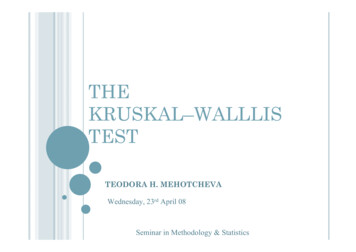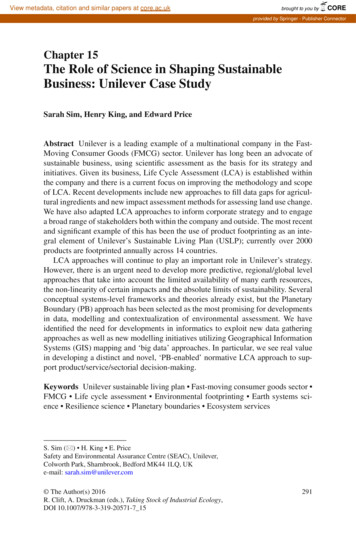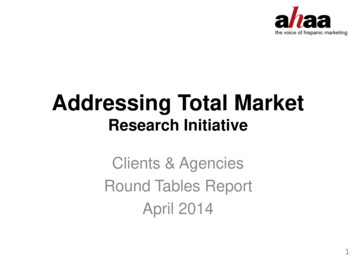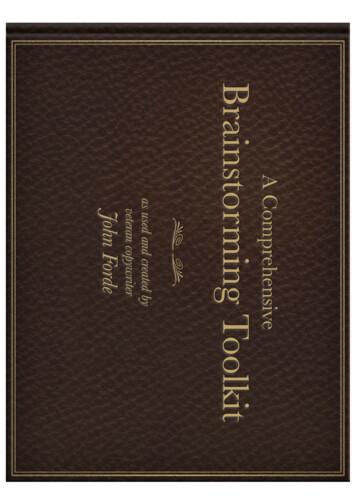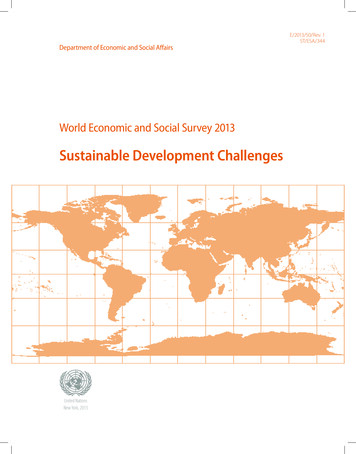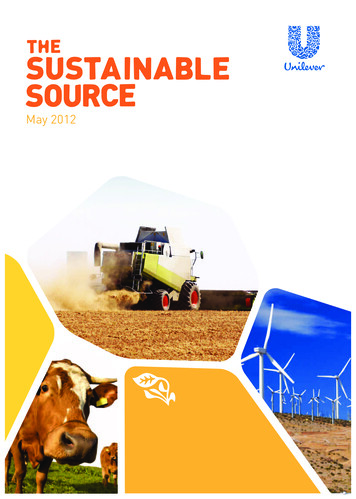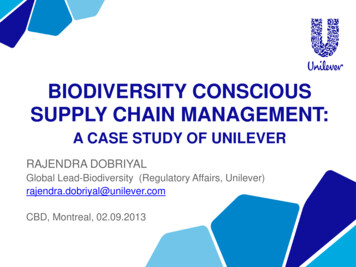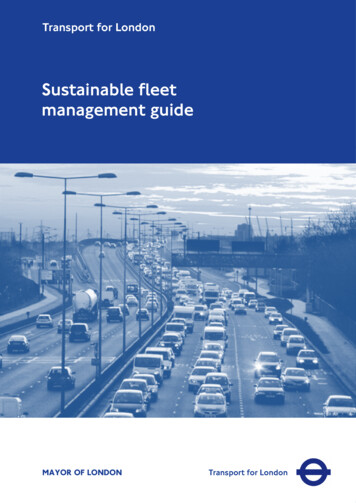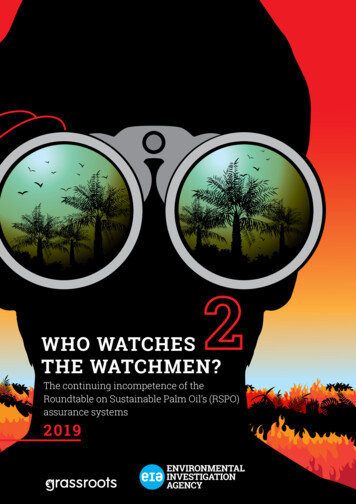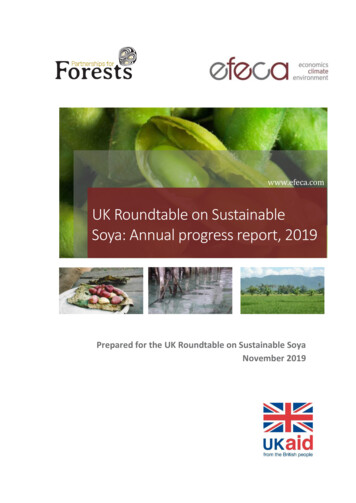
Transcription
www.efeca.comUK Roundtable on SustainableSoya: Annual progress report, 2019Prepared for the UK Roundtable on Sustainable SoyaNovember 2019
Table of Contentswww.efeca.com1.Introduction . 52.Background . 62.1. The soya supply chain . 62.2. The scale of the challenge . 62.3. The role of supply chain actors - demand side . 73.Main Findings: UK soya imports . 83.1. Soya meal imports . 83.2. Soybean imports . 93.3. Soya Oil . 103.4. Inter-Europe trade. 103.5Imported products containing soya: embedded soya . 113.6Total soya . 133.7Sustainability . 144.Main findings: UK Roundtable on Sustainable Soya . 164.1Assessment and policy . 164.2Timebound plans . 174.3Implementation. 184.4Data challenges and opportunities. 185.Impact of the UK Sustainable Soya Initiative . 205.1Supporting a mass market movement. 205.2Impact of UK soya consumption: land use . 206.Conclusions . 22Annex A Soya consumption methodology . 231.1. Data sources . 231.2. Indirect soya imports . 241.3. Measuring Progress of Roundtable members . 251.4. Assumptions . 26Annex B Soya certification schemes . 27Efeca2UK Roundtable on Sustainable Soya
Executive summaryIn March 2018 an industry-led UK Roundtable on Sustainable Soya was convened by the UKGovernment through the Partnerships for Forest Programme, following the success of the UKRoundtable on Sourcing Sustainable Palm Oil which was created in 2012.The purpose of this report is to provide an update on progress towards meeting the goal of theUK Roundtable. This report builds on a baseline study completed in 2018, prior to the launch ofthe UK RT and sets out our current understanding of the UK soya footprint in terms of volumes,source and sustainability credentials at a national level, as well as progress made by themembers of the Roundtable.Current position of UK imports, consumption and sustainabilityThe UK imports soya beans, meal and oil directly from producer countries and through intertrade with Europe. Approximately 90% of the EU’s soya is used to feed livestock and this istypically used in the form of soya meal.In total the UK annually imports approximately 3.2 million tonnes of soya bean equivalentsdirectly in the form of soya beans, meal and oil. Of this figure, most soya is sourced from SouthAmerica either directly (68%) or through the Netherlands, and from the USA. Furthermore, atleast 0.6 million tonnes of additional soya are imported indirectly ‘embedded’ in products.Between 2017 and 2018 we have seen a shift in UK sourcing volumes away from Brazilian soyato US soybeans, but the sources of soya meal (the majority of the UKs soya consumption) hasremained static. This shift has been as a result of the US/China trade dispute, where the USA andChina has imposed mutual 25% tariffs on a range of products. In practice, China effectivelystopped purchasing US soybeans. The EU does not currently have import tariffs on soybeansand so, as US soybeans have become cheaper relative to Brazilian and Argentine soybeans afterChina’s retaliatory tariff imposition, the EU has increased its soya imports from the US.It is estimated that as of October 2019, 27% of soya consumed in the UK was covered by adeforestation and conversion free soya standard.This is a significant increase (12%) from the baseline report, which showed only 15% of soyawas covered by a deforestation and conversion free standard. We anticipate that this figure willincrease in line with the new or strengthened commitments made over the past year by eightmajor retailers and other UK RT members. When these commitments are fully implemented thecombined tonnage could represent an estimated third of the UK’s soya consumption alone.UK Roundtable member progressSince the launch of the Roundtable, there has been significant progress made by UK industry,with 8 of the major retailers either creating or strengthening their sustainable soya sourcingpolicies, representing 83% of the retail market share. When fully implemented these combinedpolicies will represent a soya production area 2.5 times the size of London. There has also beensignificant support from other roundtable members including the major protein producers, whowith the support of the Roundtable established the physical supply chain working group tocollaborate on increasing the mass market uptake of sustainable soya and exploring how UKEfeca3UK Roundtable on Sustainable Soya
industry could move beyond buying sustainable soya credits to more directly support soyaproducers.ImpactOver the past year, there has been greater collaboration across UK industry and across Europeto improve data gathering and analysis across these areas. In 2018 the Retail Soy Groupcommissioned research on their individual supply chains, to provide greater understanding ofsoya sourcing and origin within retail supply chains, how soya is used across these supplychains and the status and verifiability of sustainability claims currently being made. At theOctober 2019 Roundtable, the AIC announced their plans to research the proportion of soyaused by the various animal sectors with the support of their members.Through the Amsterdam Declaration Partnership, the UK SSI has engaged with several othernational initiatives, including the Netherlands, France, Germany, Sweden, Norway and Austria todevelop a workplan of activities (including greater collaboration on monitoring and reporting)and towards a joint statement setting out a commitment to deforestation and conversion freesoya and ways of supporting this goal. In September 2019, the Danish Soy Alliance waslaunched, facilitated by the Danish Initiative for Ethical Trade. The Alliance is the first of its kindin Denmark and has taken inspiration and learnings from the UK SSI and the Swedish SoyDialogue approaches.Next stepsThere remain challenges, and in the coming year Efeca as facilitator of the Roundtable will striveto engage with sectors who are not currently well represented in the Roundtable such as foodservice as well as meat and dairy brands.There is also a need to provide more support to UK producers, who must implement changewhile responding to a range of customer policies and plans. To support producers, Efeca willwork with industry associations to develop sector specific plans to support industry achieve amass market transition to deforestation and conversion free soya.The next annual progress report will provide a final update on the UK’s consumption of soyaand Roundtable member progress towards the goal of the UK Roundtable. The next report willbe published in October 2020.Efeca4UK Roundtable on Sustainable Soya
1. IntroductionIn March 2018 an industry-led UK Roundtable on Sustainable Soya (UK RT) was convened bythe UK Government through the Partnerships for Forest Programme, following the success ofthe UK Roundtable on Sourcing Sustainable Palm Oil which was created in 2012. This soyaRoundtable aims to facilitate the discussions of buyers and specifiers of soya in the UK and issupported by a wider UK Sustainable Soya Initiative.Concerns about the impacts of soya production have largely focused on links to deforestation inSouth America. While a much broader range of environmental, social and economic factors havebeen considered and are important, there is a danger in setting a very wide scope that clarity ofpurpose and impetus for action is lost. For this reason, the focus of the UK RT, has been to focusfrom the outset on the deforestation and conversion agenda.1.1.The UK Roundtable on Sustainable SoyaThe role of the Roundtable is to provide buyers and specifiers of soya in the UK with a platformto provide: a renewed impetus for action on sustainable soya – ‘the need to act’ consensus around a framing goal and scope – ‘what we want to achieve’ stronger and closer collaboration on the practicable steps necessary to convert the Goal intoaction plans within supply chains – ‘what we need to do’ a means of tracking and communicating our progress ‘how are we doing?’Through private-public collaboration, the Roundtable aims to support long term sustainabilityof agricultural industries in producing countries and a mass market move to secure, resilientsupplies of sustainable soya to the UK and the UK livestock industry.The following goal was agreed by members of the UK Roundtable on Sustainable Soya at ameeting of members on the 12th July 2018, at the full launch of the UK RT following severalworking group meetings:“The UK recognises the need to accelerate progress towards a secure, resilient supply ofsustainable soya to the UK.The UK Government supports Roundtable signatories’ commitment to soya that is legal andcultivated in a way that protects against conversion of forests and valuable native vegetation.This will be achieved by signatories committing to: Publish timebound plans, by April 2019, to achieve this; Meaningful and demonstrable progress towards this Goal by 2020”1.2.This reportThe purpose of this report is to provide an update on progress towards meeting the goal of theUK Roundtable. This report builds on a baseline study completed in 2018, prior to the launch ofthe UK RT and sets out our current understanding of the UK soya footprint in terms of volumes,source and sustainability credentials at a national level, as well as progress made by themembers of the Roundtable. This report uses the latest national data (calendar year 2018) andmatrix of progress submissions collected over September 2019.Efeca5UK Roundtable on Sustainable Soya
2. Background2.1.The soya supply chainSoybeans are a highly versatile globally traded commodity with a wide variety of uses includingas a source of protein in livestock feed, directly as a food ingredient (e.g. tofu) and in productssuch as biodiesel and detergents.1 In terms of global soya production, the majority of soya iscrushed to form meal and the majority of this is fed to animals (see Figure 1 below). Soybean oilis also the second largest source of vegetable oil globallyFigure 1 Global soybean production, by volume2The largest producers of soybeans are the USA, Brazil, Argentina and China, Global productionhas more than doubled over the past 20 years, with the market now exceeding USD 115billion.3 The large increase in soya consumption can be attributed in part to the increase inglobal population growth but also to the rise in prosperity, leading to a growing middle classand increasing demand for meat.4 Approximately 90% of soya consumed in the EU is used inlivestock feed, mostly as soya meal as this has a high protein content.2.2. The scale of the challengeExpansion in the production of commodities such as soya, timber and cattle ranching has been asignificant driver in the loss of forest and other native vegetation in South America, withconsequent environmental impacts (e.g. on biodiversity, carbon emissions and water systems)and social impacts (e.g. through poor practices in the application and use of pesticides and landspeculation/land grabbing.) Inside the Cerrado, Matopiba is at the forefront of agriculturalexpansion, with the soybean area increasing by 253% between 2000 and 2014.5Engage the Chain https://engagethechain.org/soybeansEngage the Chain https://engagethechain.org/soybeans3 Engage the Chain https://engagethechain.org/soybeans4 Soy Barometer 2014 uploads/2017/03/07102143/141.105.120.208 dsc wp-content uploads 2014 04 Soy-Barometer2014.pdf5 36.full12Efeca6UK Roundtable on Sustainable Soya
Considerable efforts have been made to halt deforestation, through global-leadingenvironmental legislation such as the Forest Code in Brazil and the Amazon Soy Moratorium, across-sector agreement that since 2006 has dramatically reduced forest loss in the AmazonBiome. More recently the Grupo de Trabalho do Cerrado (GTC) a collaboration of organisationsrepresenting the soya industry, consumer goods manufacturers and retailers, civil society,producer organisations and government and finance institutions has been working towards anagreement to ensure that Brazilian soya production in the Cerrado does not cause theconversion of native vegetation.The scale of the challenge remains considerable. Recent fires in the Amazon, though not linkedto soya expansion, have highlighted the need to strengthen efforts to protect globally significantforest systems, whilst at the same time recognising that this must be done in a way that secureslong term benefits for farmers and local communities.2.3. The role of supply chain actors - demand sideBusinesses trading or using soya within their supply chain, whether in feed or as a directingredient in food products are under increasing scrutiny from NGOs, consumer groups,investors and government to ensure this soya is sustainably sourced.In the UK, a significant number of leading companies have existing time bound commitments toeliminate deforestation that are approaching key implementation timescales (zero-netdeforestation by 2020 in the case of members of the Consumer Goods Forum6) and are needingto demonstrate progress made and the remaining actions now necessary to make good on thiscommitment ‘post 2020’. The UK government itself is a signatory to the New York Declarationon Forests and the Amsterdam Declarations under which the government is committed tosupporting the private sector to transition to sustainable supply chains for agriculturalcommodities.The imperative for accelerated actions to address deforestation is growing though there is anincreasing recognition that solutions require multi stakeholder collaboration, beyond theinfluence of any single actor including those companies within soya supply deforestation/Efeca7UK Roundtable on Sustainable Soya
3. Main Findings: UK soya importsThe UK imports soya beans, meal and oil directly from producer countries and through intertrade with Europe. While soya oil can be used to produce biofuels, according to the UKDepartment for Transport only 0.04% came from soya sources in 2018.7 Approximately 90% ofthe EU’s soya is used to feed livestock8 so this report will focus on soya used in animal feed.3.1.Soya meal importsThe soya used in animal feed is typically used in the form of soya meal. The UK imports just over2 million tonnes of soya meal per year, from the following countries:2017Top exporters2018Share in UKimports (vol)%Quantity(tonnes)Share inUKimports(vol) %Quantity(tonnes)Year onYear (YoY)volumechange%Argentina63%1, 213, razilUSAOther countriesTotal15%10%4%2%1%295, 843184, 83178, 98544, 62033, 17267,1101, 918, 05,4463%15%-7%34%78%5%15%11%4%3%3%3%5%36%5%The majority of the UK’s imported soya meal is sourced from South American producers (71%).These countries produce ‘Hi-Pro’ soya, which has a higher protein content in comparison tosoya grown in Europe and makes it more suitable for use in animal feed. Within South Americavarious economic policies have made Argentina the top exporter of soya meal to the UK,whereas Brazil remains the top exporter of whole soya beans.This year, the top exporting countries to the UK have remained unchanged, but there have beensome changes in the volume of soya being imported from these countries, with a year on year(YOY) reduction in Argentinian imports (6% down) but an increase in imports fromNetherlands and Paraguay. Overall, we have seen a small (5%) increase in total imports. Themost significant year on year (YoY) change has been in soya meal imported from Brazil. Whileonly 3% of the total UK import of soya meal, the volume of Brazilian meal has nearly doubled(78%). This is likely due to price fluctuations as a result of the US/China trade tariffs, which willbe addressed in more detail dfEfeca8UK Roundtable on Sustainable Soya
3.2.Soybean importsIn 2018, the UK imported 744,797 tonnes of soya beans from the following countries:2017Top exporters2018Share in UKimports (vol) %Quantity(tonnes)Share inUKimports(vol)%Quantity(tonnes)Year onyear (YoY)volumechange 60744,79746%-79%118%89%23%756,750-2%The soya beans imported into the UK are crushed, and the resulting meal typically used inanimal feed.This year has seen significant changes to the proportion of soya being imported from variousproducer countries, the most significant being a decrease in imports from Brazil and increase inimports from the USA. This is largely a result of the China/USA trade dispute. In July 2018, USPresident Trump's administration imposed a 25% tariff on a range of products imported fromChina, which Beijing promptly matched with a 25% import tariff on a selection of US goods,including soybeans. In practice, China effectively stopped purchasing US soybeans.9 Accordingto mid-October 2018 federal data, Trump’s 'America First' trade policies led to a 94% drop in USsoybean exports to China compared to 2017’s harvest.10 The EU does not currently have importtariffs on soybeans and so, as US soybeans have become cheaper relative to Brazilian andArgentine soybeans after China’s retaliatory tariff imposition, the EU has increased its soyaimports from the US. While there were several attempts to resolve the tariff dispute over2018/19 the US-China trade relationship remains ng-a8641671.html910Efeca9UK Roundtable on Sustainable Soya
3.3.Soya OilThe UK also imports a relatively small amount of soya oil, approximately 127,309 tonnes in2018, a significant decrease of 37% from 2017 data. This reduction may be as a result ofindustry switching to alternative oils such as palm, rape or sunflower oil due to fluctuations inprice. There has also been a market shift away from fried foods which may have had an impacton oil imports overall.2017Top exporters(2017)2018Share in UKimports (vol)%Quantity(tonnes)Share inUKimports(vol)%Quantity(tonnes)Year onyear(YoY)volumechange 7122,145127,309121%123%3.4.203,345-37%Inter-Europe tradeSoya is typically imported directly from producer countries as it is more cost effective. However,some of the UK’s soya does come via inter-European trade, the majority coming as soya meal viathe Netherlands (particularly via Rotterdam). This is unsurprising given the role of theNetherlands as a hub for international trade. Whereas in 2018 nearly 60% of Dutch importswere sourced directly from South American producers, in 2019 this figure fell to 49% (sourcedfrom Brazil and Argentina). These were largely replaced by imports of bean and meal from theUSA, and this change is likely driven by the China/USA trade war as described above see Figure3 below:Efeca10UK Roundtable on Sustainable Soya
Netherlands soya meal source countries inaDutch soybean and meal imports (2018)5.6%1.6%1.4%0.7%43.6%43.5%United States of AmericaBrazilArgentinaChinaBelgiumGermanyFigure 3 Top sources of soya meal for the Netherlands 2017 and 20183.5Imported products containing soya: embedded soyaIn addition to importing soya bean, meal and oil for consumption in the UK, each year the UKalso imports products that will have soya ‘embedded’ within them, for example, poultry or porkwhich will be reared abroad on a diet including soya and then exported for consumption in theUK market.To calculate the volume of imported ‘embedded’ soya there are several conversion factorsavailable (for information on conversation factors see Annex A), which can be used to calculatea proxy value of soya as part of the whole product. Several of these conversion factors are setout in the table below; as can be seen, there is significant variation between different sources,most notably across beef. This may be a result of differences at a country level e.g. in countriesEfeca11UK Roundtable on Sustainable Soya
where cattle are reared predominantly on grass the reliance on soya will be much smaller.Within the UK we know that there will be variances across livestock sectors depending on thedegree of home-mix vs compound feed used. For this reason, an average across the differentsources has also been provided. This form of data analysis is continually being discussed andrefined, and Efeca is currently working with Agricultural Industries Confederation (AIC) whoare conducting a study on the volume of soya used by each animal sector within the UK, tosupport the whole supply chain to better understand their soya usage and sourcing.Volume ofUK imports(000 tonnes,2017)PoultryPorkCheeseBeefMargarineEggsMilk (perlitre)Soyavolumes(estimate)Averagesoya 292Volume of UKimports(000 734284,91073,30433,374106,637WWF RiskBusiness report(2017)Dutch 503,150685,357656,436.08645,472Based on the range of conversion factors above, the UK indirectly imports an estimated500,000-750,000 tonnes of soya in the form of meat and dairy products, the majority of which is‘embedded’ within imported poultry (45%) and pork (22%) see Figure 4 below. Thesepercentages are largely unchanged from 2017: poultry (43%), pork (22%), cheese (15%) andbeef (12%).Efeca12UK Roundtable on Sustainable Soya
Embedded soya rEggsMilkFigure 4 Breakdown of imported embedded soya by product113.6Total soyaIn total the UK annually imports approximately 3.2 million tonnes of soya bean equivalentsdirectly in the form of soya beans and meal.Typically, soya consumption is reported as ‘soya bean equivalents’, this is because when abean is crushed, 80% forms the meal and 20% the oil.To convert the volume of soya meal into soya bean equivalents, you must thereforeaccount for the oil that was also part of the original soya bean. In the case of the UK:2,005,446 (soya meal) / 0.8 2,506808756,750 (soya beans) 744,797Total 3,251,605Note: the volume of soya oil imported to the UK is covered in the soya meal volumesOf this figure, most soya is sourced from South America either directly (68%) or through theNetherlands, and from the USA, see figure 5 below. Of the UK’s Dutch imports, 49% areestimated to be of South American origin, and 44% from the USA (a 16% increase in US sourcingcompared to 2017). Between 2017 and 2018 we have seen a shift from Brazilian soya to US soyabeans, but the sources of soya meal (the majority of the UKs soya consumption) has remainedstatic.11Calculated by Efeca using UN COMTRADE data and the average of reported proxy figures.Efeca13UK Roundtable on Sustainable Soya
Paraguay, 8%China, 2%Argentina, 44%Ireland, 3%USA, 10%Other(32%)Netherlands, 12%Brazil, 16%Other countriesFigure 5 Breakdown of imported soybean equivalents by country of exportWhen the total soya bean equivalents figure is added to the average estimated volume of soyaembedded in imported products, the total volume of soya consumed in the UK is estimatedto be 3.9 million tonnes.3.7SustainabilityEstimating the proportion of soya imported into the UK that can be considered as being from a‘sustainable’ source is problematic as there are a range of approaches taken to the definition of‘sustainable’ in relation to soya across currently available sustainable soya certificationschemes. For more information on certification schemes, see Annex B of this report.The approach taken by Efeca is to Reference definitions developed by the Accountability Framework Initiative whereavailable; and Look for measurable indicators that point to the application of sustainability criteria tosourcing decisions that support the key principles of the Goal of the Roundtable, namelyensuring legality and protection against the conversion of forests and valuable nativevegetation for soya cultivation.Efeca gathered confidential data submissions from UK soya buyers and specifiers and sensechecked these findings with scheme owners to reduce the risk of double counting across thesupply chain, for example reporting credits twice at a producer and retailer level.Based on these confidential submissions, it is estimated that as of October 2019 27% of soyaconsumed in the UK was covered by a deforestation and conversion free soya standard.Of the schemes reported by members, all were benchmarked as meeting the criteria of theFEFAC - Soy Sourcing Guidelines but going beyond these guidelines to specify no deforestationand conversion requirements. RTRS was the most commonly used scheme, representing 22% ofthe soya consumed in the UK, followed by Proterra (3%) and the trader owned standards e.g.Cargill Triple S, Cefetra Responsible Soy (CRS) and ADM Responsible Soybean Standard 2ndEfeca14UK Roundtable on Sustainable Soya
edition representing 2% combined. Of this soya, nearly all was purchased within a credits-basedsystem (where there is no physical link to the soya in the supply chain) but 2% of the UK’s totalsoya imports was purchased as either mass balanced or segregated.Trader standards, 2%RTRS, 22%Deforestation/conversionfree status unknown73%Proterra, 3%Figure 6 Breakdown of soya deforestation/conversion free statusThis is a significant increase (12%) from the baseline report, which showed only 15% of soyawas covered by a deforestation and conversion free standard. We anticipate that this figure willincrease in line with the new or strengthened commitments made over the past year by eightmajor retailers and other UK RT members. When these commitments are fully implemented thecombined tonnage could represent an estimated third of the UK’s soya consumption alone.Efeca15UK Roundtable on Sustainable Soya
4. Main findings: UK Roundtable on Sustainable SoyaOf the publicly listed members of the Roundtable at the time of this publication (2212), 82%13completed Matrix of Progress to feed into this
to US soybeans, but the sources of soya meal (the majority of the UKs soya consumption) has remained static. This shift has been as a result of the US/China trade dispute, where the USA and China has imposed mutual 25% tariffs on a range of products. In practice, C
